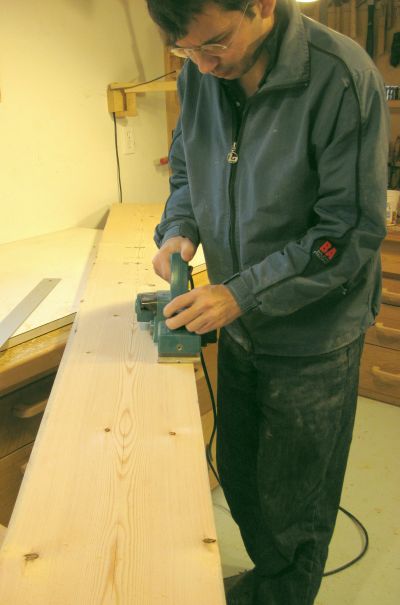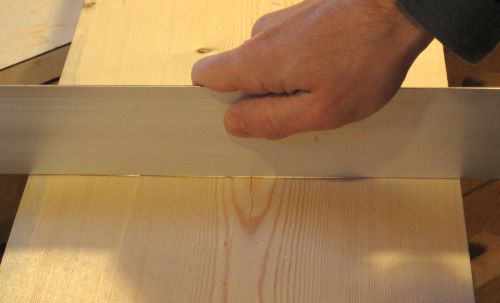Flattening wide boards
 Hobbyist grade jointers are usually 6" (15 cm) wide, whereas a cheap thickness planer will always
have about 12" (30 cm) of cutting width. So given a board that is more than 15 cm wide,
the challenge is how to initially flatten one side without a wide enough jointer.
Hobbyist grade jointers are usually 6" (15 cm) wide, whereas a cheap thickness planer will always
have about 12" (30 cm) of cutting width. So given a board that is more than 15 cm wide,
the challenge is how to initially flatten one side without a wide enough jointer.
I have seen some complicated and awkward methods published, ranging from building a sled to pass through the planer that supports the uneven side of the board, or building an elaborate contraption to flatten it with a router. Another technique is to deeply joint it as wide as the jointer will go (effectively cutting a 6" wide rabbet on one side), and then place a precise board into the cut out rabbet to serve as a spacer and pass it through the planer with that side facing down. That technique also has its problems. You can only go about 5 cm wider than your jointer, and you also can only make one pass on the jointer. If that one pass turns out to not be deep enough, there's no way to go back and fix it.
It mystifies me why people use such complicated techniques. I just don't have the time
and patience for all that.
So I use one of those hand-held power planers and just plane off the high spots.
I plane down the outside edges of the concave side and check it with a ruler until the board
is reasonably flat.
 The part that makes it easy is that I don't need to produce a continuous smooth surface.
All I need is a side that is approximately flat. Once I have that, I pass it
through the thickness planer with my approximately flat side down. After that, I flip
the board over and give my approximately flat side one light pass through the
planer to smooth it out.
The part that makes it easy is that I don't need to produce a continuous smooth surface.
All I need is a side that is approximately flat. Once I have that, I pass it
through the thickness planer with my approximately flat side down. After that, I flip
the board over and give my approximately flat side one light pass through the
planer to smooth it out.
There's the possibility that the board may still have a slight bit of twist or bow to it.
For long wide boards, I personally prefer not to take out the twist. Usually,
it doesn't take much force to just flex the board straight. Planing a twist or a bow out of
a long and wide board sacrifices a lot of wood.
I use this technique primarily to get rid of slight cupping in the board. If the boards
become part of a larger glue-up such as a table top, I can force out any bow or
twist while gluing it up. Once the board is part of a larger assembly, the force of
a slight bow or twist just isn't enough to warp the whole piece of furniture.
See also: Jointing boards wider than the jointer
Back to the Shop tricks section